Many vehicle owners consider applying window tint to their vehicles. They desire to do such for a wide variety of reasons. One reason that a car owner may want to apply a window tint is design. Sometimes a nice dark tint can jazz up the outer appearance of a vehicle. Some drivers like to have window tint because it may keep them cooler during the summer months. Additionally, some drivers have medical conditions that cause them to be extra-sensitive to light. No matter what one’s reason is for desiring vehicle window tint, that person must ensure that such is allowable according to the law. The following is some information on window tinting laws for vehicles:
Is There a Nationwide Window Tint Law?
Every state has different regulations concerning vehicle window tinting. Some states are much more lenient about tinted windows than others are. The logic behind strict window tinting laws is the hindrance that police offers have when they approach a vehicle. Therefore, many states regulate their window tinting laws to please the law enforcement agencies. Some states such as Pennsylvania and Minnesota do not allow tinting of the windshield in any way.
Windshield Tinting Regulations
Most states within the United States have the strictest regulations on the tinting of the windshield. Several states bar windshield-tinting altogether. However, states such as Alabama, Georgia, New York and New Hampshire allow tint up to six inches under the top of the windshield. States such as South Carolina, Florida and Delaware would like tinters to keep their tint above the AS1 line. Some states bar window tint from the front sides of the vehicle. Examples of such states are Colorado, New Jersey and New Hampshire.
Percentage of Vehicle Light Transmission
States regulate window tinting by the amount of light transmission that the tinting makes, as well. Regulations only allow for a certain level of darkness. The state of Alabama requires vehicles to have 32 percent of vehicle light transmission on the front and backsides of the vehicle. Minnesota requires 50 percent of vehicle light transmission. New York requires vehicle light transmission of 70 percent in the front and back.
Percentage of Reflectivity
Every state has a requirement about the reflectivity that the tint displays. Arizona, Missouri and New England have a 35 percent reflectivity rule. Arkansas has no regulation about reflectivity in its rulebook at all.
Restricted Colors
Some states restrict window tint by colors. In other words, they forbid certain colors from being on any part of the vehicle. The state of Florida apparently restricts all colors of window tint. New Jersey does not specify the colors it restricts. The state of Oregon restricts the use of red, gold, amber, yellow and black. The state of California restricts red, amber and blue.
Accommodations for Medical Issues
According to Autographix, some states will allow window tinting if a driver needs it because of a provable medical condition. We talked with them about this subject because they said, “The person would have to produce a special permit for the police department to ignore the call for a citation. Most states will tolerate window tinting for medical reasons. Some of the states that will not tolerate window tinting for medical reasons include Connecticut, Colorado, North Dakota, Vermont, Kansas and Kentucky.”
Choosing the Right Window Tint
Making the choice to tint one’s windows is a huge step. The best way to make the correct choice is to visit the Department of Motor Vehicles in the area and ask someone for the specific regulations for the state. An interested person would also want to ensure that a window tinting shop would follow the state’s regulations.




